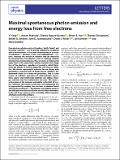Maximal spontaneous photon emission and energy loss from free electrons
Author(s)
Yang, Yi; Massuda, Aviram; Roques-Carmes, Charles; Kooi, Steven Earl; Christensen, Thomas; Johnson, Steven G.; Joannopoulos, John D.; Miller, Owen D.; Kaminer, Ido; Soljacic, Marin; ... Show more Show less
DownloadYangMa18.pdf (8.503Mb)
Terms of use
Metadata
Show full item recordAbstract
Free-electron radiation such as Cerenkov, Smith–Purcell and transition radiation can be greatly affected by structured optical environments, as has been demonstrated in a variety of polaritonic, photonic-crystal and metamaterial systems. However, the amount of radiation that can ultimately be extracted from free electrons near an arbitrary material structure has remained elusive. Here we derive a fundamental upper limit to the spontaneous photon emission and energy loss of free electrons, regardless of geometry, which illuminates the effects of material properties and electron velocities. We obtain experimental evidence for our theory with quantitative measurements of Smith–Purcell radiation. Our framework allows us to make two predictions. One is a new regime of radiation operation—at subwavelength separations, slower (non-relativistic) electrons can achieve stronger radiation than fast (relativistic) electrons. The other is a divergence of the emission probability in the limit of lossless materials. We further reveal that such divergences can be approached by coupling free electrons to photonic bound states in the continuum. Our findings suggest that compact and efficient free-electron radiation sources from microwaves to the soft X-ray regime may be achievable without requiring ultrahigh accelerating voltages.
Date issued
2018-07Department
Massachusetts Institute of Technology. Research Laboratory of Electronics; Massachusetts Institute of Technology. Institute for Soldier Nanotechnologies; Massachusetts Institute of Technology. Department of Electrical Engineering and Computer Science; Massachusetts Institute of Technology. Department of MathematicsJournal
Nature Physics
Publisher
Springer Nature America, Inc
Citation
Yang, Yi, et al. “Maximal Spontaneous Photon Emission and Energy Loss from Free Electrons.” Nature Physics 14, 9 (July 16, 2018): 894–899. © 2018 The Authors
Version: Author's final manuscript
ISSN
1745-2473
1745-2481